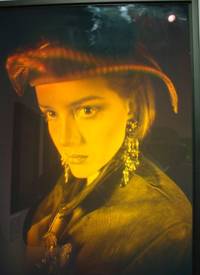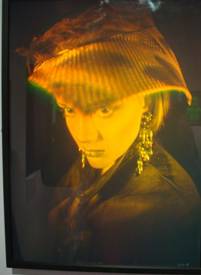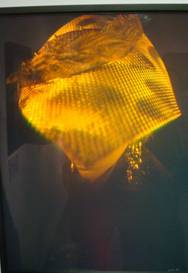
Holography Critiques
Lucy in a Tin Hat Critique by Patrick Boyd



Lucy in a Tin Hat by artist Patrick Boyd is what I would call the “Mona Lisa” of holographic art. This piece sets the bar in holographic representational art, and serves as an excellent example of what a skilled holographic artist can achieve with the medium. While many excellent holographic portraits exist, Lucy is much more than simply a holographic portrait; she is a holographic art masterpiece. The three figures here, taken from the hologram, are meant only for guidance and in no way simulate the experience of viewing the hologram.
Boyd exploits at least three features of great holographic art, 1) an excellent technical quality, 2) excellent artistic strategy and esthetics, and 3) outstanding exploitation of the holographic medium to achieve what cannot be achieved by other art
From a technical point of view Lucy demonstrates a quality that is rarely seen in holograms, since holographic artists often offer “artistic license” as an excuse for poor technical quality. It has a very wide range of viewing, large depth of field, high resolution, bright, clear image and a large dynamic range with no visual defects. The piece was produced by projecting the three dimensional image from a master hologram into a new recording, one of the many ways to produce art holograms.
Boyd exploits conventional art strategies often employed in great portraiture, capturing an extremely intense expression of an elegant woman. Her eyes are the focal point of the piece, positioned strategically in the golden section* with a golden face surrounding the golden section and a classical three quarter view (at first glance). The black background and a black leather jacket eliminate all distraction and enable the widest range of both value and contrast, far greater than you can ever see in a photograph or painting.
As in all great art, compositional tricks lead the viewer’s eye to explore the entire frame. Lucy’s hand leads the viewer’s eye to move back along the highlighted jacket collar, around her gleaming hair, and along the hat brim in a full rhythmic circle about her face and jewelry. This would be a great portrait even if it were two dimensional, but we have just begun to look, and we are already intrigued and may not even consciously know why.
Boyd’s composition exploits features unique to holography. The strategically placed, long, ear rings play an important role in enhancing parallax, a feature that is lost in photography. On first viewing, my left eye can see clearly the left ear ring which is hidden to the right eye by parallax, a clear signal to my brain that this is a three dimensional Lucy, even before I move my head. The guiding lines in the piece cause my eyes to move around the frame further enhancing this effect. This invites me to move sideways until the ear ring comes in view to both my eyes and allowing me to view both sides of Lucy’s face. Boyd has placed her eyes in the plane of the hologram, where they will be in sharper focus than any other plane (a characteristic of this type of holography).
Upon first viewing, Lucy gazes off to the side of the frame, but I am led to move until I can look straight into her eyes, giving me almost a full range from head on to profile. In a photograph or painting eyes will follow you. Not so in holography, where from an optical of interpretation, this is the equivalent of having the real Lucy trapped and frozen behind a window. I can choose either to observe her or communicate directly with her. Through holography Boyd allows me to interact with Lucy.
Vertical parallax, available in this type of holography, is usually wasted since our two eyes are horizontal-not so in this piece. But here a well designed hat protrudes far in front of Lucy’s face. Consequently, as I raise my point of view the hat blocks my view of her face telling me that I am now rising above her. Indeed, I see the top of her hat that blocks her face. Boyd has made the perfect choice in monochrome. The black, which is not really a color, combined with gold appears as a second color, and provides the widest possible range of values and contrasts. This gives us the impression of seeing more color than really exists in the image.
An art piece such as Lucy does not happen by accident; it takes knowledge, talent, design, planning, creativity, good equipment, probably a lot of failed attempts and also luck. This piece is successful not simply because it is a good hologram; it is successful because Boyd has integrated and successfully exploited the medium of holography with good art practise. Hologram copies of this piece can be purchased for about 2000 pounds.
*Note: The golden section is a well known “sweet spot” in art located approximately one third from two sides of the frame, so that the ratio of distances to the sides is the so called “divine ratio”.